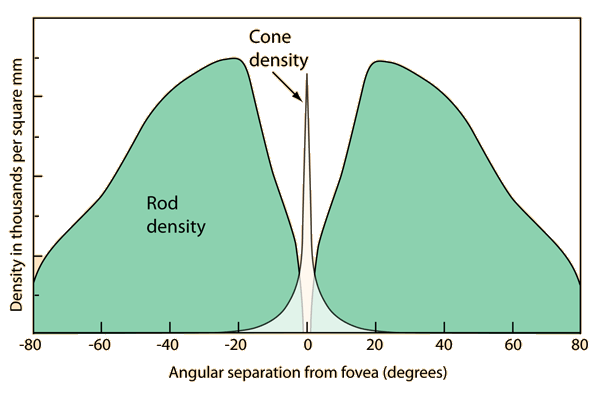“The retina contains two types of photoreceptors, rods and cones. The rods are more numerous, some 120 million, and are more sensitive than the cones” (Fortner). Rods are responsible for dark adaptation, and they are not sensitive to color. Rods can reportedly be triggered by individual photons under optimal conditions. “The 6 to 7 million cones provide the eye's color sensitivity and they are much more concentrated in the central yellow spot known as the macula. In the center of that region is the " fovea centralis ", a 0.3 mm diameter rod-free area with very thin, densely packed cones” (Fortner).
“While the visual acuity is much better with the cones, the rods are better motion sensors. Since the rods predominate in the peripheral vision, that peripheral vision is more light sensitive, enabling you to see dimmer objects in your peripheral vision” (Williamson). If you see a dim star in your peripheral vision, it may disappear when you look at it directly since you are then moving the image onto the cone-rich fovea region which is less light sensitive. You can detect motion better with your peripheral vision, since it is primarily rod vision. It makes evolutionary sense then that cones are more dense in the center of the retina, whereas rods are more dense in the periphery. 10,000 years ago, when we were walking through the woods, and an animal was attacking form the periphery, it didn’t matter what color the animal was, we just needed to know something was coming.

References:
Fortner, Brand and Meyer, Theodore E., Number by Colors, Springer-Verlag, 1997
Williamson, S J and Cummins, H Z, Light and Color in Nature and Art, Wiley 1983.
Color blindness can either be genetically inherited or acquired through eye diseases such as macular degeneration or glaucoma. Our color sensory comes from three types of cone cells within our eyes that detect the colors, red, green, and blue. It would be interesting to know if the strength of our rod cells have any correlation to our cone cells or vise versa. Is our peripheral vision capacity dependent on our cone cells?
ReplyDeleteAfter watching an episode of Mythbusters, I learned that supposedly, the reason pirates would wear eye patches was not because they had lost an eye, but just in case they had to go down a deck quickly without having time for their eyes to adjust. At first, I thought this was kind of strange and not believable. But because I know that rods are the reason we can see in low light, I did some research and found that rods work by means of rhabdomeric receptor pathways that can see a wide range of light levels – from sunlight to near pitch blackness (Osorio, 2011).
ReplyDeleteThe reason our eyes need to “adjust” to dark environments is because the rhabdomeric receptor pathway has traded efficiency for quality of sight. It takes minutes for our rods to adjust to the event known as “bleaching” (Osorio, 2011). “Bleaching” is the process of the break-down of rhodopsin into retinal and an opsin molecule – these are the fuel for our cones to take over our eyesight (Discovery Health, 2011). After these molecules recombine into rhodopsin, we are able to see in the dark.
After doing the research, it doesn’t seem too far off to assume that pirates wore eye-patches just to keep one eye adjusted to the dark.
Resources
Osorio, D. (2011). Light sense. Nature, 472, 300-301. Retrieved from
Discovery Fit and Health (2011). At night, why does it take several minutes for my eyes to get used to darkness? Retrieved from health.howstuffworks.com on 12/2/11.